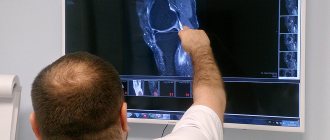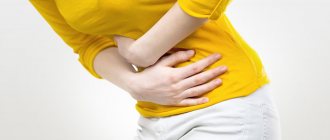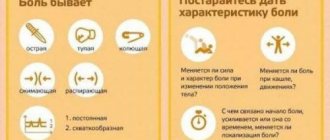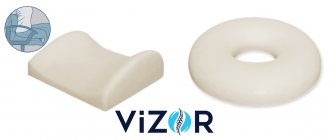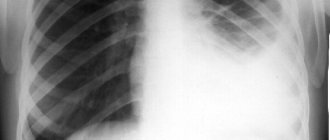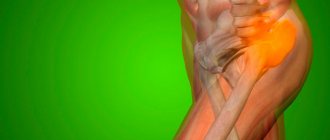The main causes of pain under the left shoulder blade
There are many causes of pain, but they can all be divided into 2 groups:
- Pain associated with pathologies of the musculoskeletal system. Pain under the left shoulder blade can be caused by osteochondrosis of the cervical or thoracic region, intercostal neuralgia, osteomyelitis, bone tuberculosis, scapula injuries, rib fracture or crack, myofascial or scapulocostal syndrome, glenohumeral periarthritis.
- Pain that occurs due to diseases of the internal organs. Pain under the left shoulder blade can be a symptom of heart disease, bronchopulmonary system, gallbladder, stomach ulcers, esophageal spasm, exacerbation of pancreatitis.
Rare pathologies that cause pain radiating to the shoulder blade include splenic rupture. This pathology requires immediate surgical treatment, since massive abdominal bleeding occurs with a risk of death.
No less dangerous for the body is pain in the back on the left under the shoulder blade, which develops against the background of cardiac diseases:
- dissection of an aneurysm of the ascending aorta;
- cardiac ischemia;
- angina pectoris;
- pericarditis, myocarditis, pericarditis;
- myocardial infarction.
Pain in the left shoulder blade from the back, which radiates to the arm and chest area, may indicate heart disease. Numbness of the limb often occurs. Depending on the disease, accompanying symptoms appear: lack of air, compression of the throat, squeezing of the chest, a feeling of cardiac arrest.
Pain under the left shoulder blade may appear during pregnancy due to increased stress on the back
Let's take a closer look at the main causes of pain under the shoulder blade from the back on the left.
Gallbladder diseases
With cholecystitis and cholelithiasis, heaviness appears in the right side, pain radiating under the shoulder blade on the left. An acute attack of inflammation of the gallbladder causes severe pain, nausea, vomiting, and increased body temperature. If it is provoked by obstruction of the bile ducts by a stone, the pain syndrome occurs as biliary colic.
With chronic inflammation, the nature of the pain is aching. Unpleasant sensations appear after eating fatty foods, with long breaks between meals.
Relapses of attacks can occur after physical or nervous strain, against a background of stress.
Subphrenic abscess
It is an accumulation of pus under the diaphragm. Most often, an abscess forms on the right side, but left-sided localization is also possible. The pathology is manifested by the following symptoms:
- pain in the left side, radiating under the scapula to the sternum;
- acute pain in the chest, which intensifies when inhaling;
- high body temperature;
- hiccups;
- increased sweating;
- nonproductive cough;
- dyspnea.
Without treatment, the disease can cause empyema, pneumonia, and lung abscess.
Bronchopulmonary diseases
Diseases of the lower respiratory tract (bronchi, lungs and pleura) cause both chest and scapular pain, which are always complemented by a specific bronchopulmonary clinical picture:
- increased body temperature;
- weakness, lethargy;
- labored breathing;
- chest pain (usually from the affected lung) of moderate intensity, which intensifies when coughing or inhaling;
- cough;
- wheezing.
Pain syndrome in the back of the back in the area of the left shoulder blade most often occurs with pneumonia, dry pleurisy, pneumothorax, acute bronchitis or abscess of the left lung.
With tumors, back pain in the area of the left shoulder blade is not accompanied by fever and high temperature, but there is a cough and breathing problems
Kidney diseases
Scapular pain may occur due to problems with the right kidney, since it is located close to the scapula. With its inflammation, the formation of purulent infiltrates or stones, the pain is often localized on the right, but can also radiate to the left. The pain is often dull or aching, but can also be sharp. It is paroxysmal, ascending, that is, it rises from the lower back, accompanied by nausea, vomiting, and elevated body temperature.
Diseases of the musculoskeletal system
Problems with the spine and neurological disorders associated with them are the main cause of back pain in the area of the left shoulder blade. Pain can occur with any movement, turning the body, sneezing, breathing, or taking a deep breath. They can radiate into the arm, combined with a crunching sound and limited mobility.
Often pain in the scapula area occurs due to the following diseases:
- cervical and thoracic osteochondrosis;
- herniated intervertebral discs;
- protrusion;
- scoliosis;
- radiculitis.
Against the background of degenerative processes in the spine, not only blood vessels and nerve endings are pinched, but also muscles spasm. Muscle spasm provokes the occurrence of scapular-costal syndrome.
One of the most common causes of pain in the scapula is cervical osteochondrosis. At first, the pain syndrome is mild, but as degenerative changes occur, it becomes acute and shooting. The pain is accompanied by dizziness, tinnitus, blurred vision, and increased blood pressure.
With cervical osteochondrosis, pain radiates to the arm
More rare diseases of the musculoskeletal system that can provoke scapular pain include osteomyelitis, bone tuberculosis, and malignant neoplasms.
Muscle strain and inflammation
The back muscles that surround the shoulder blade support the spine in an anatomically correct position and protect the internal organs that are located nearby. Their inflammation or injury is not only accompanied by pain, but also provokes a decrease in muscle tone and the occurrence of instability in the shoulder.
Intercostal neuralgia
The disease is accompanied by inflammation of the intercostal nerves and appears against the background of the following provoking factors:
- injuries to the ribs or spine;
- hypothermia;
- excessive physical activity;
- osteochondrosis.
The intensity of the pain syndrome depends on the severity of the pathology and the timeliness of treatment. The pain can be aching, but sometimes it hurts so much that you can’t stand it.
It is important to contact a neurologist in time, who will provide qualified and, most importantly, timely assistance, otherwise intercostal neuralgia will cause a person severe discomfort:
- the pain becomes shooting, cutting in nature;
- pain increases when moving your hand, coughing or inhaling;
- numbness occurs in the affected area of the body;
- heart rhythm is disturbed.
A neurologist with more than 10 years of experience sees patients in a medical clinic. Only he can correctly determine what causes the sudden pain under the left shoulder blade - neuralgia or cardiac pathology. It is impossible to make a correct diagnosis on your own.
Diseases or injuries of the scapula
Cracks and fractures of the scapula, glenohumeral arthritis are accompanied by pain, limitation of movement, damage to blood vessels and pinched nerve endings.
Injuries to the scapula are more common among athletes, patients with osteoporosis, and cancer of bone tissue.
Causes of chest pain on the left
Cardiac ischemia
Currently, ischemic heart disease is a common cause of pain in this localization.
In a stable form, the pain syndrome begins during physical activity, fast walking. The functional class of stable angina is determined by the duration of the distance traveled, after which symptoms develop. Unpleasant sensations are caused by insufficient blood supply to the myocardium. The pain in the left side of the chest has a compressive, pressing nature, forcing the patient to stop walking or other physical activity. The symptom is accompanied by tightness in the chest and the inability to take a deep breath. Irradiation of pain into the shoulder blade and left arm is typical. With a complicated course of coronary artery disease and unstable angina, attacks of pain on the left side of the chest are observed more often, and are not always caused by physical activity. In severe situations, pain is observed at rest, accompanied by cyanosis and shortness of breath. Attacks of angina last from 5 to 30 minutes and are well controlled by taking nitroglycerin. Chest pain lasting more than half an hour against the background of a rapidly deteriorating condition is a serious symptom and requires immediate medical attention.
Myocardial infarction
Pain in the left side of the chest resembles a typical angina attack, but lasts 30 minutes or more. Pain during myocardial infarction is not relieved by nitroglycerin, and the patient gets worse every minute. A sharp pallor of the skin and cyanosis of the nasolabial triangle are noticeable, cold sticky sweat appears on the forehead. The pain is so severe that it becomes difficult to breathe, and fainting often occurs. If a person remains conscious, he may experience extreme feelings of fear and panic. If assistance is not provided in a timely manner, the pathology can be fatal.
Inflammatory heart diseases
Non-coronary causes cause acute stabbing or constant nagging pain to the left of the sternum, the intensity of which depends on the extent of the inflammatory process. With infective endocarditis, pain develops against a background of general weakness and sweating, and an increase in body temperature to febrile. The heart hurts constantly, the discomfort intensifies with deep breaths, but does not change during physical activity. In elderly people and patients with immunodeficiency, the symptoms are mild, pain is accompanied by shortness of breath and heaviness in the chest.
A similar clinical picture occurs with myocarditis. With infectious-allergic inflammation of the heart muscle, symptoms appear 2-3 weeks after tonsillitis or tonsillitis. I am concerned about moderate pain in the chest on the left, a feeling of palpitations and interruptions in the functioning of the heart. In acute myocarditis, pain occurs simultaneously with fever, weakness, and nocturnal hyperhidrosis. The chronic process is characterized by moderate discomfort in the heart area, shortness of breath and increased fatigue.
Cardiomyopathy
The severity of pain depends on the form of the disease. With hypertrophic cardiomyopathy near the sternum on the left, periodic stabbing or squeezing pains are observed, the appearance of which does not depend on external factors. With dilated cardiomyopathy, aching pain occurs in the heart, which intensifies during habitual physical activity. A person periodically feels shortness of breath and lack of air, and in the mornings they are bothered by weakness and dizziness. As the pain intensifies, signs of heart failure increase - swelling in the legs, ascites.
Arrhythmia
Heart rhythm disturbances are manifested by periodic stabbing or squeezing pain in the left chest, which usually begins without warning or exogenous influences. The pain during arrhythmia is sharp and severe, the patient freezes for a short time in one position, and grabs the heart area with his hand. At the same time, tachycardia and palpitations are determined. As a result of ineffective blood circulation, severe weakness and darkening of the eyes, pallor of the skin, and lightheadedness occur. Symptoms often disappear on their own within a few minutes.
Heart defects
Anatomical defects in the structure of the heart and efferent vessels cause anginal pain in the chest - squeezing or pressing, radiating to the clavicle area, poorly relieved by nitroglycerin. In addition to pain, signs of circulatory failure are detected: shortness of breath during exercise, dry cough, swelling of the neck veins. In children, chest pain on the left side can be caused by congenital developmental abnormalities that appear as the child grows. Causes that provoke cardiac pain syndrome:
- Mitral valve prolapse
. - Acquired defects
: mitral, aortic, tricuspid, combined forms. - Congenital “white” defects
: atrial and ventricular septal defects, coarctation of the aorta, patent ductus arteriosus. - Congenital “blue” defects
: tetralogy of Fallot, Ebstein’s anomaly.
Hypertonic disease
Chest pain develops in the later stages of hypertension, when degenerative changes occur in the heart muscle and coronary vessels. The pain syndrome is usually associated with spasm and obliteration of the arteries supplying the heart, and is manifested by compressive sensations that do not have a clear localization. During a hypertensive crisis, the pain intensifies and is accompanied by a rapid heartbeat and flashing “spots” before the eyes. Frequent dull or pressing pain in the heart is often caused by the secondary addition of atherosclerosis.
Dissecting aortic aneurysm
The severity of symptoms in dissecting aneurysm correlates with the degree of damage to the aorta. When only the inner lining of the vessel ruptures, patients experience sharp pain in the chest on the left and a faint state. In case of ongoing rupture and dissection of the aortic membranes, severe pain occurs in the chest cavity, which radiates to the back and shoulder girdle area. The pain syndrome is so intense that the person often loses consciousness due to shock. Continued bleeding causes a drop in blood pressure, collapse and deep fainting.
TELA
With massive thromboembolism of large trunks of the pulmonary artery, sharp stabbing pain in the chest suddenly appears without clear localization. Pain syndrome with pulmonary embolism is accompanied by a feeling of lack of air, shortness of breath, and cyanosis of the skin. If help is not provided, loss of consciousness and cardiac arrest occurs. Blockage of small vessels and focal pulmonary ischemia are causes of moderate chest pain, which intensifies and reaches its maximum after a few days. Pain during a pulmonary infarction is combined with hemoptysis and severe cough, which indicates the development of infarction-pneumonia.
Systemic connective tissue diseases
Many rheumatic processes occur with damage to the heart, which causes pain on the left side of the chest. Painful sensations due to collagenosis occur periodically and are of a pressing, stabbing or squeezing nature. Irradiation of pain syndrome is uncharacteristic. The symptom is not associated with stress or other external factors. The pain is accompanied by palpitations, shortness of breath, and fatigue. Most often, a similar clinical picture occurs with rheumatism. Less commonly, similar symptoms are caused by systemic lupus erythematosus, dermatomyositis, and vasculitis.
Respiratory diseases
Visceral pain is often associated with inflammatory damage to the left lung, pleura and bronchial tree. In this case, constant pain is typical, which is aggravated during bouts of coughing and deep breathing. Other signs of an infectious process are also typical: sputum production and febrile body temperature. The most common causes of pain in the left chest are:
- Bronchitis
. With purulent inflammation, mild pain in the chest is bothered, accompanied by discomfort behind the sternum and sore throat. Painful sensations occur against the background of a deep cough with scanty sputum. - Pneumonia
. In the focal form of the disease, moderate dull pain is felt in the left chest, which intensifies with coughing. Lobar pneumonia is characterized by severe diffuse chest pain, which is accompanied by high fever and difficulty breathing. - Pleurisy
. Pain syndrome localized in the inferolateral surface of the chest on the left is typical for inflammation of the pleura. The pain intensifies with coughing and body movements, patients are forced into a forced position on the painful side. - Tuberculosis
. Painful sensations of medium intensity, diffuse. When the pleura is involved in the pathological process, the pain intensifies and becomes clearly localized. The symptom is combined with shortness of breath, cough, scanty sputum, and profuse night sweats are characteristic.
Hiatal hernia
When the hernial protrusion is small, periodic discomfort occurs in the middle of the sternum and to the left of it. As the size of the hernia increases, sharp pains in the chest and epigastrium appear, which develop after eating, lifting weights, or against a background of stress. The duration of the symptom is from minutes to several hours. Along with the pain, dysphagia increases, even swallowing water becomes difficult. Constant intense pain on the left side is typical for a strangulated hernia, which requires emergency medical attention.
Pathology of the abdominal organs
The proximity of the nerve endings and segments of the spinal cord responsible for visceral innervation explains why there is pain in the chest area on the left when the digestive system is damaged. Such pain can be disturbing in acute pancreatitis and splenitis, since these organs are located in the abdominal cavity on the left, directly under the diaphragm. Symptoms sometimes occur with hematomas and ruptures of the spleen. The pain syndrome is also caused by organic causes - the inflammatory process spreads from the abdominal organs to the chest through the diaphragm.
Depression
Heart pain is one of the “masks” of a depressive state, which is provoked by disturbances of autonomic innervation and the development of cardioneurosis. Symptoms appear for no apparent reason and are detected in people of any age, more often in women. The pain is variable and usually appears in the early morning hours. Patients with depression tend to describe their discomfort at length and in detail. The pain is often preceded by a feeling of “heart sinking” and heaviness in the chest. The pain syndrome cannot be relieved with standard cardiotropic drugs.
Rare causes
- Pathology of nervous structures
: intercostal neuralgia, herpes zoster. - Diseases of the musculoskeletal system
: myalgia and myositis, inflammation of the costal cartilages on the left, chest injuries. - Left-sided pneumothorax
. - Damage to the stomach and esophagus
: GERD, hyperacid gastritis, peptic ulcer.
Types of pain under the shoulder blade on the left
Before proceeding with diagnosis and treatment, it is important to understand the nature, localization, intensity of pain, their connection with movement, breathing, and eating. If it hurts below the left shoulder blade after eating, then heart pathologies and diseases of the musculoskeletal system can be ruled out. The cause of pain is diseases of the gallbladder, pancreas, and stomach.
The nature of the pain syndrome can be girdling, acute, burning, increasing, aching, dull, sharp.
Aching pain in the left shoulder blade
It can be constant or periodic, indicating both pathologies of internal organs and diseases of the spine. Without treatment, it can turn into a stabbing, burning sensation. Attacks more often occur when raising an arm, physical activity, or staying in one position for a long time.
Appears with scoliosis, chronic cholecystitis, scapular-costal syndrome, intervertebral disc herniation, initial stages of cervical osteochondrosis, bruises and other mild injuries, intercostal neuralgia.
Acute pain under the left shoulder blade
This is a severe pain syndrome in the back below the shoulder blade, which limits movement and makes breathing difficult. Characteristic for myocardial infarction, bursitis of the shoulder joint, exacerbation of osteochondrosis, spondylosis, hernia, subphrenic abscess, pleurisy, acute cholecystitis, intercostal neuralgia.
In case of myocardial infarction, pain under the scapula from behind is not relieved by analgesics, it decreases after taking nitroglycerin
Sharp pain in the area of the left shoulder blade
It may occur suddenly or be the result of prolonged aching pain. Shooting, sharp pain is a sign of osteochondrosis, hernia, trauma, intercostal neuralgia, tuberculosis of the scapula, aortic aneurysm, perforated gastric ulcer, radiculitis.
Stitching pain behind the left shoulder blade
It manifests itself as lumbago, which is typical for pinched nerve endings in diseases of the musculoskeletal system. If it is accompanied by compression of the chest and lack of air, then myocardial infarction or lung abscess cannot be ruled out.
With a perforated stomach ulcer, pain occurs, as if stabbed with a knife.
Nagging pain in the left side of the back under the shoulder blade
Inherent in most pathologies of the musculoskeletal system, as well as bronchopulmonary diseases.
Constant pain on the left side under the shoulder blade
Such pain does not leave the patient even in a lying position. It interferes with sleeping, breathing, and walking. More often, pain intensifies with physical activity, coughing, and sneezing.
Constant nagging or aching pain occurs with injuries to the spine or scapula, scapular-costal syndrome, bronchopulmonary diseases, pyelonephritis, and oncology. Girdle pain with disorders of the digestive system is characteristic of patients with acute pancreatitis.
Burning pain on the left side of the shoulder blade
It is simply unbearable and occurs with intercostal neuralgia, myocardial infarction, angina pectoris, muscle strain.
Important! If a burning sensation that spreads to the sternum is accompanied by shortness of breath, you should immediately call an ambulance. This is a sign of a heart attack.
Pain under left breast
General information
The left breast contains the spleen, stomach, pancreas, intestinal loops, and the left side of the diaphragm . Pain in the left upper quadrant may be related to the spleen . The spleen lies very close to the surface of the body. The main job of the spleen is to remove red blood cells from the blood after they have lived normally for 120 days. It captures them, destroys them, after which their components pass into the bone marrow, where new blood cells are formed. In a number of diseases, the spleen enlarges, its capsule stretches, and this causes pain. Because the spleen is located close to the surface of the body, it is susceptible to rupture. Causes of splenic rupture can include trauma and diseases such as infectious mononucleosis.
Causes of pain under the left breast
With mononucleosis, the spleen becomes enlarged in size and has a soft consistency. And all this increases the likelihood of its rupture. Sometimes an enlarged spleen ruptures on its own. A telltale sign of splenic rupture , in addition to pain and tenderness in the corresponding area, is bluishness of the skin around the navel (due to the accumulation of blood).
Pain under the left breast may be caused by the stomach. Anything that irritates the stomach lining, causes gastritis (inflammation of the stomach) or functional dyspepsia, can cause pain. More often this pain is aching in nature, often accompanied by nausea and even vomiting. Antacid medications prescribed by your doctor will help. In general, only a doctor can tell you exactly what you have. can be with peptic ulcer disease and cancer.
After completing a series of laboratory tests and examinations (including endoscopic), the doctor will finally diagnose you and prescribe treatment. Pain in the upper left quadrant may be due to a diaphragmatic hernia. The diaphragm, which separates the chest cavity from the abdominal cavity, has an opening through which the esophagus passes on its way to the stomach. Myocardial ischemia. A feeling of pressure behind the sternum with typical radiation to the left arm; usually during physical stress, often after eating or due to emotional stress. The effect of nitroglycerin and rest is diagnostically significant. Acute myocardial infarction. The sensations are close to those described for myocardial ischemia, but are more intense and last longer (approximately 30 minutes); rest or nitroglycerin does not relieve them. III and IV heart sounds often occur. If you have pain under your left breast, you should seek help from a gastroenterologist and infectious disease specialist.
How to relieve pain under the left shoulder blade
Pain sensations below the shoulder blade on the left, especially if they are quite intense, interfere with movement and breathing freely, require qualified help, since they pose a threat to human health and life. You cannot ignore them and self-medicate. Taking analgesics, antispasmodics and other painkillers can relieve pain, but will not eliminate the cause, which must be discovered by a doctor.
Important! Emergency care will be required in case of severe pain with increasing intensity and rapid deterioration in well-being.
Which doctor should I consult for pain on the left under the scapula?
At the first painful sensation in the area of the shoulder blade, you should consult a specialist and undergo diagnostics. Since the nature of back pain is often neurological, you should make an appointment with a neurologist.
The doctor will conduct a visual examination, study the patient’s complaints, draw up a clinical picture: the nature and conditions of the pain syndrome (in a lying position, during movement), its intensity, accompanying symptoms.
With glenohumeral arthritis, pain worsens at night, when lying down
To understand exactly why your back hurts, your doctor will prescribe an additional examination:
- laboratory - clinical analysis of blood and urine, which will show the inflammatory process;
- instrumental, necessarily including MRI, since this diagnostic method provides the most accurate information about the condition of the spine, muscle tissue, nerve endings and blood vessels.
You can undergo magnetic resonance imaging using the new 2021 Siemens Symphony 1.5 Tesla device at the SmartMed clinic. Immediately after the examination, the doctor will interpret the results obtained, make a final diagnosis and prescribe effective treatment.
If instrumental diagnostics reveals a pathology that is not within the competence of a neurologist, the doctor will refer the patient to a therapist, pulmonologist, cardiologist, gastroenterologist, traumatologist or other specialists.
Why does my left side hurt under my ribs?
Pain in the left side is characteristic of diseases of the abdominal organs. Sometimes there are cases when the cause of pain can be pathologies of the lungs, heart and neuralgia. To identify the exact cause, instrumental diagnostics are used using ultrasound, x-rays and radio wave studies. Depending on the cause of the pain in the left side, appropriate treatment is prescribed. Below, we will talk in detail about the most common pathologies that cause pain. But you should understand that self-diagnosis and self-medication will most likely only worsen the condition, so you should contact a qualified specialist for help as soon as possible.
- Diseases of the spleen.
The spleen is a hematopoietic organ. Inflammation is characterized by a rapid increase in size of the spleen (splenomegaly), and with injuries there is a high risk of rupture of the organ capsule with heavy bleeding. Diseases of the organ are characterized by bursting, pressing pain in the left hypochondrium, which does not depend on physical activity and food intake. - Intestinal diseases.
Pathology of the small intestine leads to visceral or referred pain in the left side. A tumor of the left colon in the later stages of the disease causes aching pain that intensifies 2-3 hours after eating. The pain syndrome occurs against a background of weakness, weight loss, and aversion to food. - Stomach diseases.
Gastritis and gastric ulcer cause pain in the epigastric region and in the left hypochondrium. In the case of gastritis, the pain is stabbing, drilling, shooting, and intensifies after eating spicy and fatty foods. Characterized by a feeling of heaviness in the stomach, belching rotten or sour, heartburn, nausea. - Diseases of the pancreas.
Inflammation of the pancreas is called pancreatitis. Chronic pancreatitis causes indigestion and periodic pain in the left side. Characterized by diarrhea, greasy stools with lumps of undigested food, and flatulence. Pain of a stabbing, bursting, shooting nature occurs 1-1.5 hours after eating. Often the pain syndrome becomes girdling - spasmodic pain compresses the left and right hypochondrium in a “ring”. - Muscle disease.
Muscle inflammation - myositis can be accompanied by pain in the left side. The pain syndrome is shooting and cramping, intensifies when muscle fibers are stretched while bending in the opposite direction. Dull or burning pain develops when food passes through the esophagus and bends the body after eating. - Intercostal neuralgia.
Inflammation of the intercostal nerves is commonly called intercostal neuralgia. In most clinical cases, the disease develops with herpes zoster. An acute burning pain occurs, which is localized in the left hypochondrium and can spread to the back in the area of the shoulder blades and spine. Discomfort increases when bending towards the affected side. - Disease of the left lung.
Pain in the left side may appear with left-sided lower lobe pneumonia involving the pleura in the pathological process. There is a cutting, stabbing, boring pain in the left hypochondrium, which intensifies at the height of inspiration. Pneumonia is characterized by an increase in temperature up to 40 degrees, shortness of breath, weakness, dry or productive cough, wheezing when listening to breathing. - Heart diseases.
During myocardial infarction, pain occurs in the left half of the chest, between the shoulder blades, and radiates to the arm on the affected side. The atypical course of the disease leads to referred pain in the left hypochondrium. If pain occurs in the left hypochondrium, you should consult a doctor for examination and treatment. Timely consultation with a specialist reduces the risk of disease progression and complications.
Treatment of pain on the left side of the shoulder blade
All therapeutic measures are aimed at eliminating the root cause and relieving pain. The doctor selects medications based on why the pain in the shoulder blade area occurs.
If the cause is a disease of the musculoskeletal system or its complications, then drug therapy looks like this:
- anti-inflammatory non-steroidal drugs;
- muscle relaxants;
- analgesics;
- local anesthetic agents.
Drug therapy must be supplemented with physiotherapeutic treatment, massage, and therapeutic exercises. A neurologist from the SmartMed clinic draws up a comprehensive therapy program, taking into account the individual characteristics of the patient.
If conservative therapy does not provide the desired therapeutic effect, the patient is indicated for surgery


